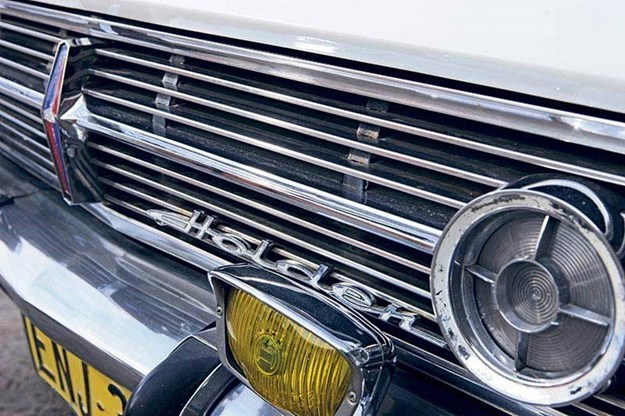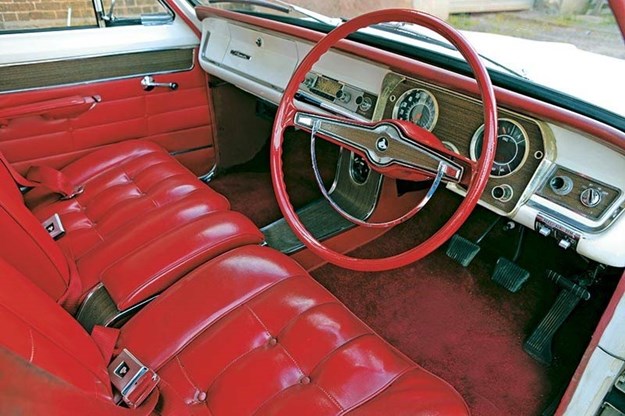Holden HD-HR 1965-1968 - Buyer's Guide



|
As the first of the Gen-5 Holdens, the HD frightened some horses. The 'hurriedly revised' HR soon calmed them down
Folklore would have us believe that the HD model was a sales disaster and needed to be hastily replaced by the more conservative HR. However, with 179,000 sold in just 14 months the HD Holden was anything but a dud. The HR was just a little less confronting.
Both models shared a body that curved to provide extra space for expanding Australians. The HD came with protruding front mudguards, wrap-around tail-lights and oddly-shaped wheel-arches that only served to emphasise the inadequacy of 13-inch wheels.
| Reader Resto: 1966 Holden HR
.jpg)
Other changes saw three-speed Hydramatic transmission replaced by a two-speed Powerglide unit which was lighter and more compact and allowed HD/HRs to incorporate a less intrusive transmission tunnel.
New tail-light and reshaped front corners characterised the HR which also delivered an improved seat design with extra padding and new ‘Sadlon’ vinyl coverings. Seats in the Premiers were reshaped and covered in Morrokide with a rear central armrest. Previous Premiers had featured full leather seat facings.
| Read next: Left-hand-drive Holden HR review
.jpg)
Engines increased in size and output with the HD’s 2.4-litre ‘149’ becoming a 2.6-litre ‘161’ in the HR and the ‘179’ enlarged to 3.1-litres or 186 cubic inches. Power increased as well, with the basic 186 cranking out 93.2kW. The twin carburettor X2 and subsequent 186S both offered 108kW.
Implementation of Australia’s first safety-oriented Design Rules saw cars built from late 1966 include front seat belts, reversing lights, padded sunvisors and a shatterproof interior mirror. Power disc brakes were an option, as was a limited-slip differential. From mid-1967, an Opel-supplied four-speed manual transmission became available. It added $85 to the price tag but sales weren’t brisk.

Even with the standard three-speed transmission, a 186-engined HR was a pretty punchy device which would hit 100km/h in 13 seconds and reach a top speed of 155km/h. At a time when fuel cost 12 cents a litre, economy didn’t bother most buyers and 15L/100km from a 186 automatic was considered reasonable. During a combined lifespan of 37 months more than 430,000 HD and HR Holdens were made. Survivors today are plentiful and, in the case of the HD at least, easier to find than they were 20 years ago.
Special and Standard models in usable condition begin at $10,000, with restored cars likely to cost more than $20,000. Utilities command similar prices to sedans but vans are very scarce and 30-50 percent more expensive than passenger versions.
.jpg)
2019 VALUE RANGE HOLDEN: (HR Premier auto)
FAIR: $9500
GOOD: $19,500
EXCELLENT: $30,000
(Note: exceptional cars will demand more)
BUYER'S CHECKLIST

BODY & CHASSIS
Just a decade ago, rusty HD and HR Holdens were still regarded as junk and being scrapped or compromised by cheap, dangerous repairs. Check wheel arches, sills, door skins and windscreen surrounds for filler and recurrent rust, also wagon, van and utility tail-gates. Areas where serious rust might make these cars uneconomic to salvage include the fire-wall, sub-frame mounting points and around the rear spring mounts. Make sure the rear-window on wagons winds smoothly. Reproduction panels and repair sections are available and used bumpers in good condition can cost $400 each. New lights and lenses, door handles and hinges are available.
.jpg)
ENGINE & TRANSMISSION
Millions of ‘red’ Holden engines were made and they are still very cheap to acquire and rebuild. Smoke from the exhaust and breather, valve and timing chain clatter, piston slap and a haemorrhaging rear main bearing seal mean a rebuild is overdue. Check also for fuel leaks around the carburettor and fuel pump. The three-speed gearbox is tough and keeps going even while suffering bearing noise, synchro and selector problems. Most of the original Opel-supplied four-speeds broke and have been replaced. Powerglide cars should upshift smoothly at around 50km/h and accept manual downshifts when slowing from 65k/h.
SUSPENSION & BRAKES
The scary part of driving an older Holden is that much of the bouncing, wandering and squirming is quite normal. Only when the front-end clunks are severe or the car won’t stop bouncing after a bump do the springs, shock absorber and bushings need some attention. The HD introduced an improved method of rear spring attachment but the leaves still flatten and crack with age. Disc front cars are preferable to those on drums and parts to upgrade or replace the original braking system are still available.

INTERIOR & ELECTRICS
If you’re not a concours d’elegance stalwart then spending money matching the original vinyl is a waste. Some restorers even go for a more comfortable but definitely non-authentic cloth retrim. If the car you’re considering has non-standard bucket seats it may also need a Modification Plate and engineering approval from when the change was made. Reproduction carpet sets, hood-linings and various detail parts are being made and door trims cost around $400 per set. These were the first Holdens to use an alternator and electrical components remain affordable. Rebuilt starter motors cost around $180.
.jpg)
1965-1968 Holden HD-HR specs
NUMBER MADE: 178,927 (HD) & 252,352 (HR)
BODY STYLES: Steel integrated body/chassis four-door sedan and station wagon, two-door utility and panel van
ENGINE: 2447-3048cc in-line six with single downdraft carburettor (twin carburettors on X2)
POWER & TORQUE: 108kW @ 4600rpm, 249Nm @ 2200rpm (186S)
PERFORMANCE: 0-100km/h 11.7 seconds, 0-400 metres 18.2 seconds (186S manual)
TRANSMISSION: three or four-speed manual or two-speed automatic
SUSPENSION: Independent with upper and lower control arms, coil springs, anti-roll bar and telescopic shock absorbers (f) Live axle with semi-elliptic springs and telescopic shock absorbers (r)
BRAKES: drum front/rear (front discs with power assistance optional)
TYRES: 6.40x13 cross-ply
Unique Cars magazine Value Guides
Sell your car for free right here
Get your monthly fix of news, reviews and stories on the greatest cars and minds in the automotive world.
Subscribe

.jpg)















